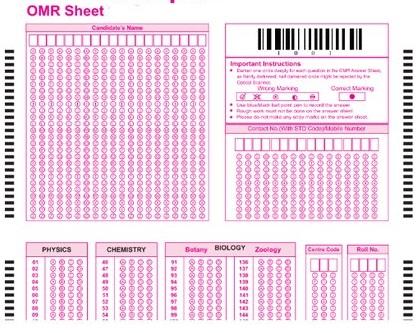All About OMR Sheets: Your Guide to Efficient Test Scoring

OMR (Optical Mark Recognition) sheets are those familiar forms filled with bubbles used for multiple-choice exams. They streamline the grading process, saving time and reducing errors. This guide explores everything OMR, from what it is to how you can leverage its efficiency.
What is an OMR Sheet?
An OMR sheet is a standardized form containing rows and columns of bubbles corresponding to answer choices in a multiple-choice exam. Students fill the bubbles with a pencil to mark their answers. OMR scanners then read these markings electronically, generating quick and accurate results.
Benefits of OMR Sheets:
- Faster Grading: OMR eliminates manual grading, significantly reducing turnaround time for results.
- Reduced Errors: OMR scanners minimize human error in interpreting handwritten answers.
- Cost-Effective: OMR sheets are relatively inexpensive to print and eliminate the need for additional grading personnel.
- Scalability: OMR is ideal for large-scale exams with a high volume of answer sheets.
OMR Sheet Uses:
- Entrance exams (SAT, ACT)
- Scholarship exams
- Standardized tests
- Online assessments
- Employee evaluations
Creating and Utilizing OMR Sheets:
- OMR Sheet Design: There are specialized software programs to design OMR sheets. These ensure proper layout, bubble size, and compatibility with scanners.
- OMR Sheet Printing: You can print OMR sheets yourself using compatible printers or outsource printing to companies specializing in OMR services.
- OMR Sheet Scanning: OMR scanners are available in various configurations, from desktop models for smaller exams to high-speed machines for large-scale testing.
Creating OMR Sheets Online:
While less common, some online platforms allow creating and customizing OMR sheets for smaller-scale assessments or practice tests.
Additional Tips:
- Always follow exam instructions regarding filling OMR sheets.
- Use a dark, soft pencil to fill bubbles completely.
- Ensure no stray marks touch bubbles you haven't chosen.
- Practice filling out OMR sheets beforehand to avoid mistakes during the actual exam.
By understanding OMR sheets and their functionalities, you can contribute to a smoother and more efficient testing experience.
- Art
- Causes
- Crafts
- Dance
- Drinks
- Film
- Fitness
- Food
- Spiele
- Gardening
- Health
- Startseite
- Literature
- Music
- Networking
- Andere
- Party
- Religion
- Shopping
- Sports
- Theater
- Wellness
- IT, Cloud, Software and Technology


